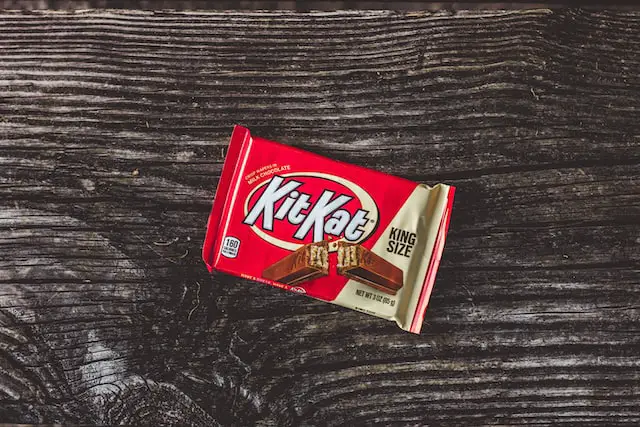In 1935, Kit Kat was introduced in the United Kingdom. Its constituent mix has been altered numerous times.
Wheat flour, sugar, cocoa butter, nonfat milk, dark or milk chocolate, milk fat, palm kernel oil, lactose (milk), a small quantity of soy lecithin, vanillin artificial flavor, salt, yeast, and baking soda are the ingredients in the new Kit Kat bar.
The bars are now smaller than in the past, but their sugar content has grown. The carbohydrate component has a total of 28 grams, with 22 grams coming from sugar.

Clearly, long-term intake can result in weight gain, an increased risk of type 2 diabetes, and elevated blood cholesterol levels.
Chocolate in the form of dark chocolate and milk chocolate can be beneficial for cardiovascular health. Milk chocolate has fewer flavonoids than dark chocolate with a cocoa content of 70% or higher.
Flavonoids are powerful antioxidants, immune system boosters, and natural anti-inflammatories. Kit Kat bars made with dark chocolate may be preferable to those made with milk chocolate.
However, the inclusion of additives during the production of chocolate candies reduces the chocolate’s nutritional content and makes it less healthful.
Contents
Nutritional Information
How many calories does a Kit Kat contain? The exact values are listed below. Let’s attempt to comprehend the Kit Kat’s calorie amount in grams.
- Calories -218
- Total Fat – 11g
- 7,5 grams of saturated fat
- Trans fat – 0
- 0.4g of polyunsaturated fat
- 2.5g of monounsaturated fat
- Cholesterol – 4.6 milligrammes
- Sodium – 23mg
- Carbohydrates – 27g
- Dietary Fiber – 0.4g
- Sugars – 20g
- Protein – 2.7g
- Vitamin D – 0
- Calcium – 52mg
- Iron – 0mg
- Potassium – 97mg
- Caffeine – 5.9mg
In 2006, it was reported that each KitKat bar contained 233 calories and 975 kilojoules. The two-piece wafer bar contained 107 calories in 2009.
KitKat is a famous candy bar for children and adults alike. They are also utilized as ice cream toppings in the majority of ice cream parlors.
High In Saturated Fats
Adding high-fat substances to achieve a chocolate flavor increases the amount of dangerous saturated fats. Kit Kat’s palm kernel oil is high in saturated fat and is used to increase the product’s shelf life and stability.
High consumption of these fats can cause cardiovascular disease, diabetes, and obesity. The regular-sized Kit Kat bar has a total of 11 grams of fat, of which 7.5 grams is saturated fat. The dark chocolate version has 15 grams of fat, of which 9 grams is saturated fat.
The American Heart Association recommends consuming no more than 7 percent of your daily calories from saturated fat.
If you consume a regular daily diet of 2000 calories, you should consume no more than 13 grams of saturated fat each day. One Kit Kat bar would provide more than half of the recommended daily intake of calories.
Is It Healthy?
The KitKat wafer bar has milk chocolate ingredients that contain carbs. The KitKat bar contains dietary fiber as a source of carbohydrates. It is a vital component of complex carbohydrates for proper digestion and bowel function.
The significance of fiber in improving blood sugar levels in individuals with hypoglycemia is crucial. It is a rapid supply of carbs that satisfies your appetite. Due to its high calorie and sugar content, excessive consumption might lead to oral problems.

A KitKat bar provides micronutrients that enable lipids, proteins, and carbohydrates to sustain a healthy lifestyle.
The micronutrient content of the chocolate bar contributes to the maintenance of healthy bones, the production of energy, and the enhancement of the immune system. Additionally, it aids in the reduction of exhaustion and tiredness.
Possibly Assists in Preventing Weight Gain
According to a study published in the journal of food chemistry, oligomeric procyanidins (PCs), a form of flavanol present in cocoa, inhibit laboratory mice from gaining weight. To reap flavanol’s benefits, you must choose dark chocolate.
These plant-based elements are contained in the cacao solids, which are more abundant in dark chocolate bars than in milk chocolate bars, which have more sugar and milk.
Due to the fact that this study was conducted on animals, we cannot necessarily draw the same conclusions for humans; however, we do know that limiting your calorie consumption will aid in weight loss.
Therefore, replacing your evening ice cream consumption with a square of lower-calorie dark chocolate can aid in weight loss.
Remember that excessive consumption of any food can lead to weight gain, therefore observe portion control! Observe the serving size.
Soy Lecithin As An Emulsifier
Kit Kat bars contain a small quantity of soy lecithin, which is used as an emulsifier. Soy lecithin adheres to both oily and aqueous substances. Thus, soy lecithin chemically helps a meal, such as chocolate, seem and taste smoother.

Soy lecithin, despite having a name that sounds like natural soybean, is not a natural food. It is a chemical substance manufactured in factories. This emulsifying ingredient consists primarily of a small portion of the soybean plant and a variety of additional compounds.
The oil extract is the most important portion of the soybean plant. The other chemicals added to soy lecithin may trigger allergic reactions in certain individuals, particularly those who are sensitive to small amounts of industrial chemicals.
Conclusion
A Kitkat bar is a fast-acting source of carbohydrates that can help stave off hunger. Occasionally consuming a one- or two-finger bar is also beneficial for your health.
KitKat bars are high in sugar and calories, which should be consumed in moderation and may cause health problems.
Nestle has been creating KitKat dark chocolate, which has numerous health benefits. You can get the dark KitKat bar related to improved cardiovascular health and glycemic control.
If you dislike dark chocolate bars, you can purchase various protein-rich chocolate bars with added minerals and antioxidants that provide a variety of health benefits.
